当前位置:网站首页>9 atomic operation class 18 Rohan enhancement
9 atomic operation class 18 Rohan enhancement
2022-07-07 19:39:00 【It will rain when the wind blows】
9 Atomic operation class 18 Luohan enhancement
Catalog
Commonly used API
Case-CountDownLatch
Object's properties modify the atomic class
Purpose of use
Use requirement
Case
interview
Deep analysis of the principle of atomic operation enhancement class
Simulate the like counter , Look at the performance
Commonly used API
Introduction
LongAdder High performance comparison Code demonstration
Source code 、 Principle analysis
principle (LongAdder Why so soon? )
The official website description and Alibaba requirements
LongAdder yes Striped64 Subclasses of
Striped64
Cell
LongAdder Why so soon?
Source code interpretation and in-depth analysis
A small summary
LongAdder.increment()
What is it?
All are java.util.concurrent.atomic Under bag
There are red boxes , There are also blue framed , Why? ?
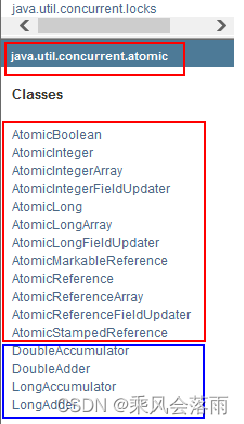
- Alibaba Java Development Manual

- Why do you say 18 Luohan enhancement , only 16 individual
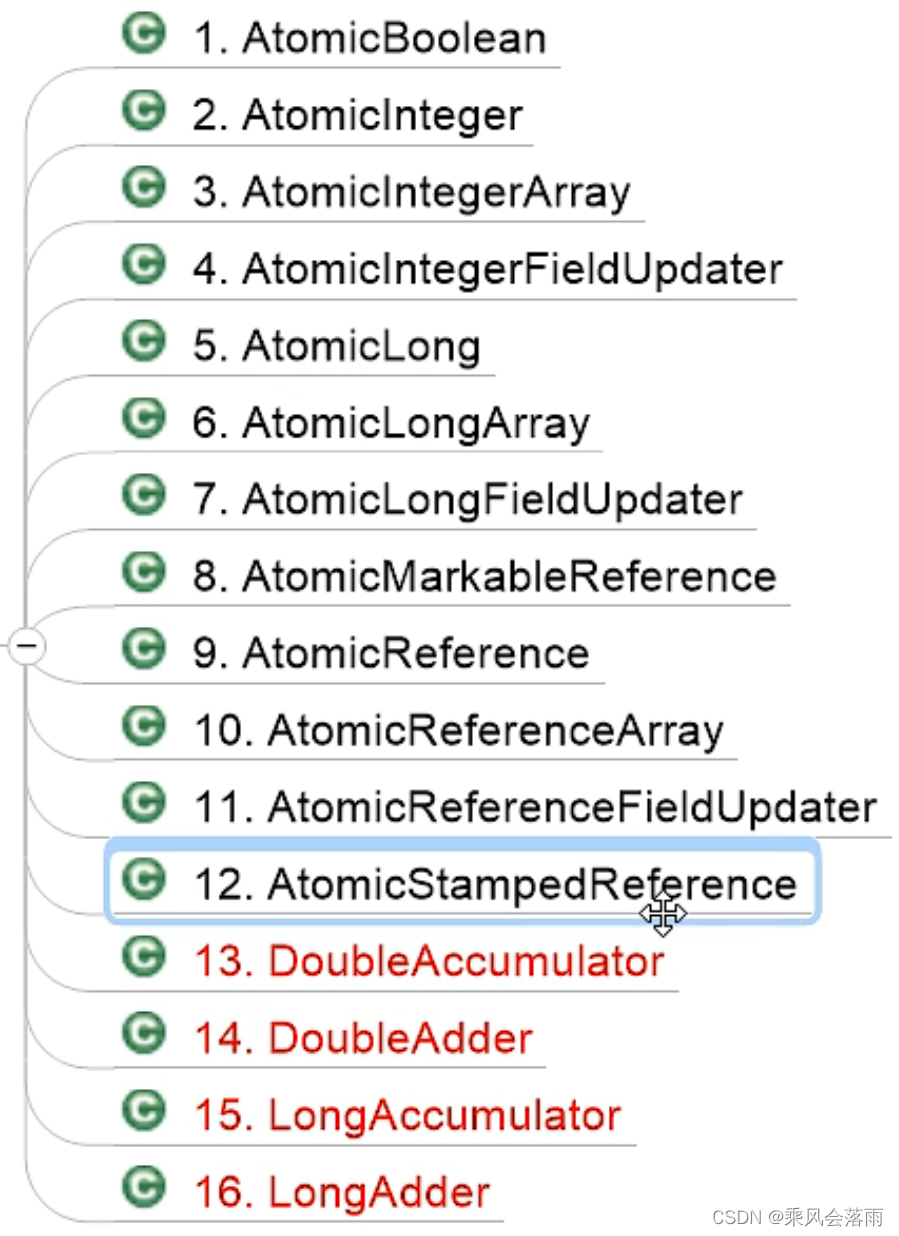
Reclassification
Basic type atomic class
AtomicInteger
AtomicBoolean
AtomicLong
Commonly used API
public final int get()
public final int getAndSet(int new Value)
public final int getAndIncrement()
public final int getAndDecrement()
public final int getAndAdd(int delta)
public comapreAndSet(int expect,int update)// If
Case-CountDownLatch
- Case study
class MyNumber{
AtomicInteger atomicInteger = new AtomicInteger();
public void addPlusPlus(){
atomicInteger.getAndIncrement();
}
}
public class AtomicIntegerDemo {
public static final int SIZE = 50;
public static void main(String[] args) {
MyNumber myNumber = new MyNumber();
for(int i = 1;i <= SIZE;i ++){
new Thread(() -> {
for(int j = 1;j <= 1000;j ++){
myNumber.addPlusPlus();
}
},String.valueOf(i)).start();
}
System.out.println(Thread.currentThread().getName()+"\t"+"result: "+myNumber.atomicInteger);
}
}
// It should have been 50000
//1 try -main result: 39000
//2 try -main result: 40178
//? Is there something wrong with our procedure ?
// Because of the above 50* 1000 The calculation is not over yet , He will go get Number
```*
solve
```java
// Method 1 ( Not recommended , do Demo ok )
public class AtomicIntegerDemo {
public static final int SIZE = 50;
public static void main(String[] args) {
MyNumber myNumber = new MyNumber();
for(int i = 1;i <= SIZE;i ++){
new Thread(() -> {
for(int j = 1;j <= 1000;j ++){
myNumber.addPlusPlus();
}
},String.valueOf(i)).start();
}
try {
TimeUnit.SECONDS.sleep(2);
} catch (InterruptedException e) {
e.printStackTrace();
}
System.out.println(Thread.currentThread().getName()+"\t"+"result: "+myNumber.atomicInteger);
}
}
// Method 2 - Subtraction counter CountDownLatch
public class AtomicIntegerDemo {
public static final int SIZE = 50;
public static void main(String[] args) throws InterruptedException {
MyNumber myNumber = new MyNumber();
CountDownLatch countDownLatch = new CountDownLatch(SIZE);
for(int i = 1;i <= SIZE;i ++){
new Thread(() -> {
try {
for(int j = 1;j <= 1000;j ++){
myNumber.addPlusPlus();
}
} finally {
countDownLatch.countDown();
}
},String.valueOf(i)).start();
}
countDownLatch.await();
System.out.println(Thread.currentThread().getName()+"\t"+"result: "+myNumber.atomicInteger);
}
}
//main result: 50000
Array type, atomic class
The basic principle is the same as above , Don't show too much
AtomicIntegerArray
AtomicLongArray
AtomicRreferenceArray
Case
public class AtomicIntegerArrayDemo
{
public static void main(String[] args)
{
AtomicIntegerArray atomicIntegerArray = new AtomicIntegerArray(new int[5]);//0 0 0 0 0
//AtomicIntegerArray atomicIntegerArray = new AtomicIntegerArray(5);
//AtomicIntegerArray atomicIntegerArray = new AtomicIntegerArray(new int[]{1,2,3,4,5});//1 2 3 4 5
for (int i = 0; i <atomicIntegerArray.length(); i++) {
System.out.println(atomicIntegerArray.get(i));
}
System.out.println();
System.out.println();
System.out.println();
int tmpInt = 0;
tmpInt = atomicIntegerArray.getAndSet(0,1122);
System.out.println(tmpInt+"\t"+atomicIntegerArray.get(0));
atomicIntegerArray.getAndIncrement(1);
atomicIntegerArray.getAndIncrement(1);
tmpInt = atomicIntegerArray.getAndIncrement(1);
System.out.println(tmpInt+"\t"+atomicIntegerArray.get(1));
}
}
Reference type atomic class
These three are relatively important
AtomicReference
AtomicStampedReference
AtomicMarkableReference
```*
`AtomicReference` Can take generics ( I talked about it before. )
`AtomicReference<xxx> `*
`AtomicStampedReference` With version number in case CAS Medium ABA problem ( I talked about it before. )
Reference type atomic class with version number , Can solve ABA problem . Solve the problem that has been modified several times .*
`AtomicMarkableReference` Similar to the above , But the solution ** Disposable ** problem
Construction method `AtomicMarkableReference(V initialRef, boolean initialMark)`
Atom updates reference type objects with tag bits
Solve whether it has been modified , Its definition is to ` Status stamp `** simplify ** by `true|false`, Similar to disposable chopsticks
```java
// Here's a case
public class AtomicMarkableReferenceDemo {
static AtomicMarkableReference markableReference = new AtomicMarkableReference(100,false);
public static void main(String[] args) {
new Thread(()->{
boolean marked = markableReference.isMarked();
System.out.println(Thread.currentThread().getName()+"\t"+" The default ID "+marked);
// Pause 1 Second thread , Wait for the next T2 The thread is in the same mode as I got flag identification , All are false
try {
TimeUnit.SECONDS.sleep(1);} catch (InterruptedException e) {
e.printStackTrace();}
markableReference.compareAndSet(100, 1000, marked, !marked);
},"t1").start();
new Thread(()->{
boolean marked = markableReference.isMarked();
System.out.println(Thread.currentThread().getName()+"\t"+" The default ID "+marked);
// Stop here 2 second , Give Way t1 First modify , then t2 Try to modify
try {
TimeUnit.SECONDS.sleep(2);} catch (InterruptedException e) {
e.printStackTrace();}
boolean t2Result = markableReference.compareAndSet(100, 1000, marked, !marked);
System.out.println(Thread.currentThread().getName()+"\t"+"t2 Threads result--"+t2Result);
System.out.println(Thread.currentThread().getName()+"\t"+markableReference.isMarked());
System.out.println(Thread.currentThread().getName()+"\t"+markableReference.getReference());
},"t2").start();
}
}
Object's properties modify the atomic class
key word FieldUpdater
AtomicIntegerFieldUpdater// Atomic update object int The value of the type field
AtomicLongFieldUpdater// Atomic update object Long The value of the type field
AtomicReferenceFieldUpdater// Atom updates the value of the reference type field
Atomic updates in a more granular range 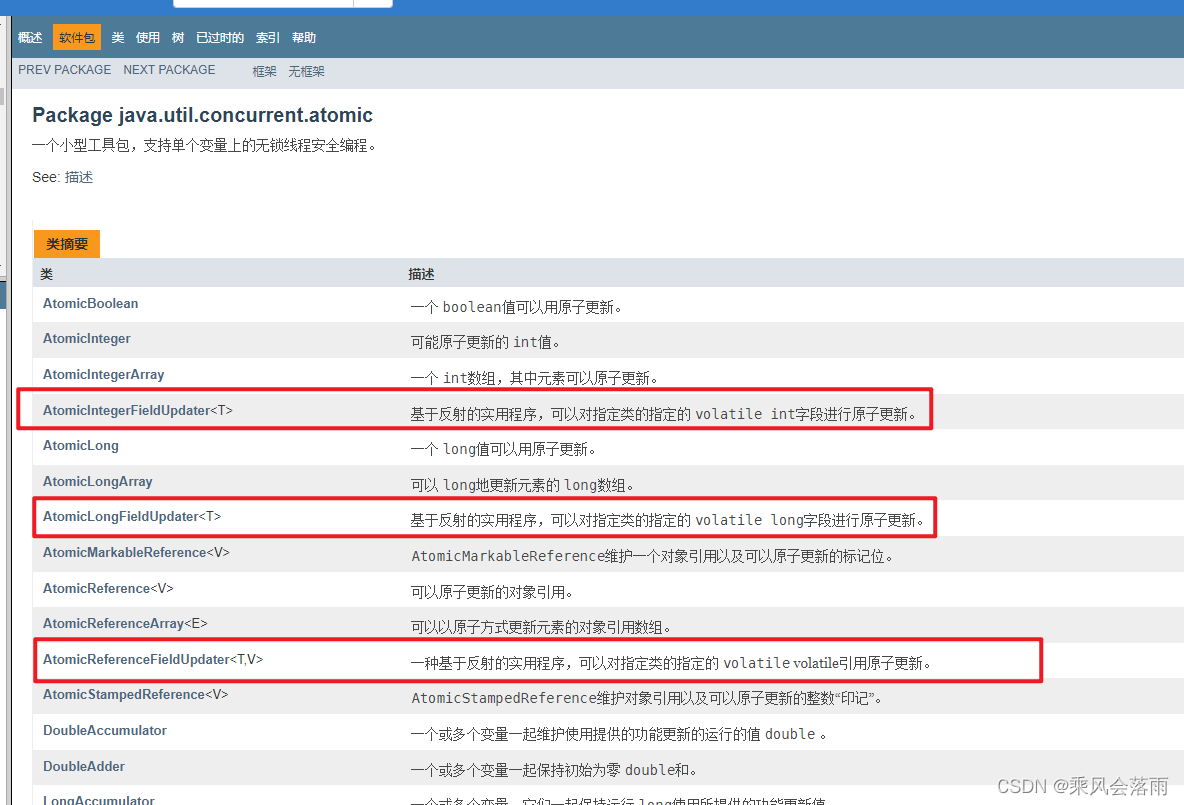
Purpose of use
- With a thread safety belt Method to manipulate some fields in non thread safe objects *
for instance ( It is more granular / Image a field , Without locking the entire object )

Use requirement
- Updated object properties must use public volatile Modifier *
Because the attribute modification types of objects are all atomic classes abstract class * *, So every time you use it, you have to use static methods newUpdater() Create a Updater * *, And you need to set the classes and properties you want to update .
Case
AtomicIntegerFieldUpdater- This is for int type
class BankAccount{
String bankName = "CCB";
public volatile int money = 0;// Conditions for a
//synchronized edition
// public synchronized void add(){
// money++;
// }
//AtomicIntegerFieldUpdater edition
AtomicIntegerFieldUpdater<BankAccount> fieldUpdater =
AtomicIntegerFieldUpdater.newUpdater(BankAccount.class,"money");// It only limits money This field , Condition 2
public void transMoney(BankAccount bankAccount){
fieldUpdater.getAndIncrement(bankAccount);
}
}
public class AtomicIntegerFieldUpdaterDemo {
public static void main(String[] args) throws InterruptedException {
BankAccount bankAccount = new BankAccount();
CountDownLatch countDownLatch = new CountDownLatch(10);
for(int i = 1;i <= 10;i ++){
new Thread(()->{
try {
for(int j = 1;j <= 1000;j ++){
// bankAccount.add();
bankAccount.transMoney(bankAccount);
}
} finally {
countDownLatch.countDown();
}
},String.valueOf(i)).start();
}
countDownLatch.await();
System.out.println(Thread.currentThread().getName()+"\t"+"result: "+bankAccount.money);
}
}
//main result: 10000
```*
`AtomicReferenceFieldUpdater`- Wider applicability
```java
// For example, this case is for boolean Type of
class MyVar{
public volatile Boolean isInit = Boolean.FALSE;
AtomicReferenceFieldUpdater<MyVar,Boolean> referenceFieldUpdater =
AtomicReferenceFieldUpdater.newUpdater(MyVar.class,Boolean.class,"isInit");
public void init(MyVar myVar){
if(referenceFieldUpdater.compareAndSet(myVar,Boolean.FALSE,Boolean.TRUE)){
System.out.println(Thread.currentThread().getName()+"\t"+"-----start init,needs 3 seconds");
try {
TimeUnit.SECONDS.sleep(3);} catch (InterruptedException e) {
e.printStackTrace();}
System.out.println(Thread.currentThread().getName()+"\t"+"-----over init");
}else{
System.out.println(Thread.currentThread().getName()+"\t"+" I'm sorry , Other threads have been initialized ");
}
}
}
public class AtomicReferenceFieldUpdaterDemo {
public static void main(String[] args) {
MyVar myVar = new MyVar();
for(int i = 1;i <= 5;i ++){
new Thread(()->{
myVar.init(myVar);
},String.valueOf(i)).start();
}
}
}
//1 -----start init,needs 3 seconds
//5 I'm sorry , Other threads have been initialized
//4 I'm sorry , Other threads have been initialized
//2 I'm sorry , Other threads have been initialized
//3 I'm sorry , Other threads have been initialized
//1 -----over init
interview
The interviewer asked you : Where did you use volatile?
stay AtomicReferenceFieldUpdater in , Because it is stipulated that it must be volatile Embellished
And before that, we were DCL In a single case , Also used. volatile Guaranteed visibility
Deep analysis of the principle of atomic operation enhancement class
At the beginning, we divide atoms into red boxes and blue boxes , Here is the content of the blue box
// These are java8 At first , The front ones are java5 And then there is
DoubleAccumulator
DoubleAdder
LongAccumulator
LongAdder
Ali is dying

Hot products like calculator , Like number plus Statistics , No real-time accuracy is required
A big one List, It's full of int type , How to realize Jiajia , Talk about ideas
Simulate the like counter , Look at the performance
- requirement : Hot products like calculator , Like number plus Statistics , No real-time accuracy is required
Look at this. LongAdder
- Look at this. LongAccumulator
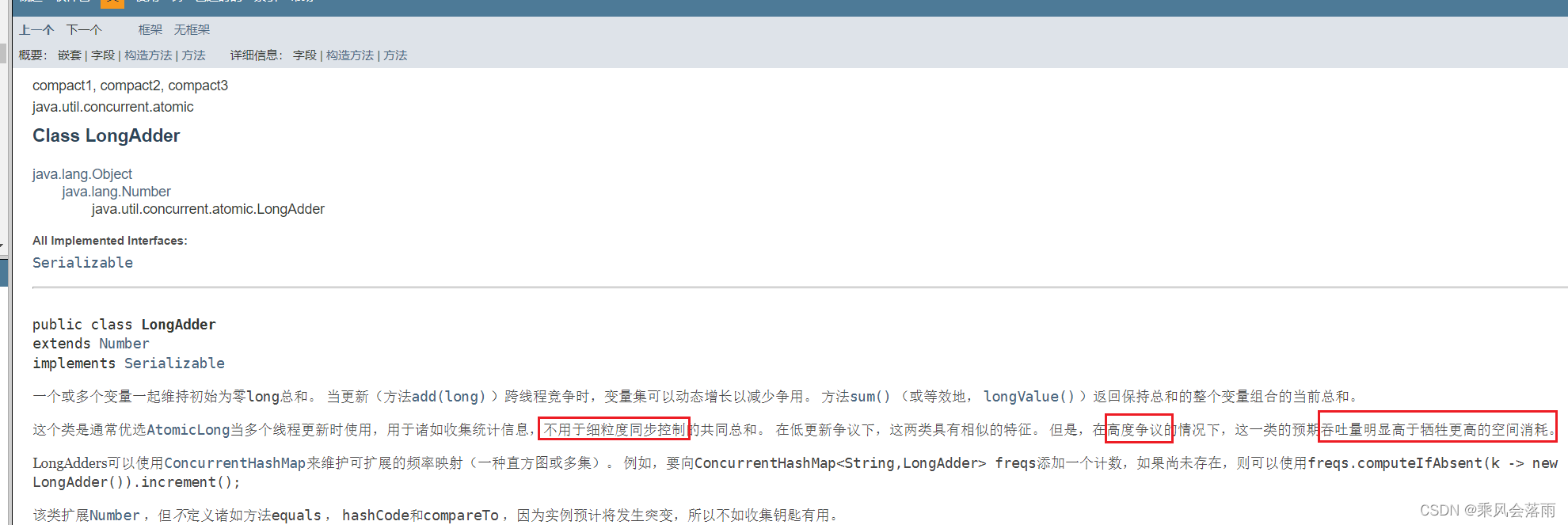
Commonly used API
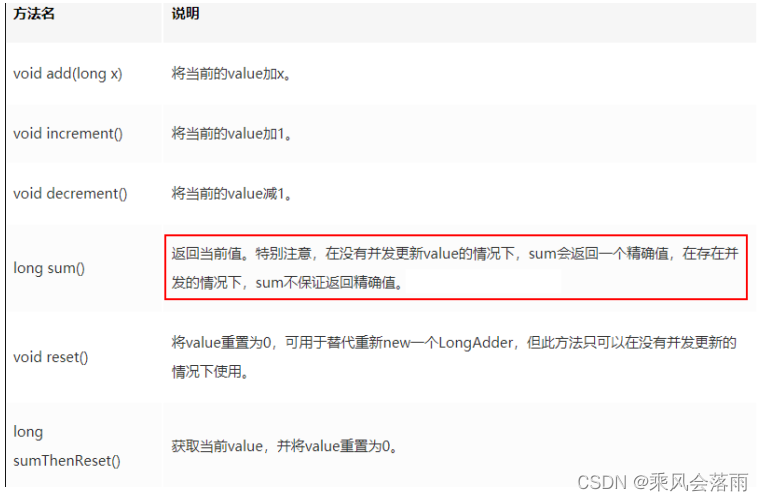
Introduction
LongAdder Can only be used to calculate addition . And start from zero
LongAccumulator Provides custom function operations ( utilize lambda expression )
public class LongAdderAPIDemo {
public static void main(String[] args) {
LongAdder longAdder = new LongAdder();
longAdder.increment();
longAdder.increment();
longAdder.increment();
System.out.println(longAdder.longValue());//3
LongAccumulator longAccumulator = new LongAccumulator((x, y) -> x + y, 0);//lambda expression
longAccumulator.accumulate(1);//1
longAccumulator.accumulate(3);//4
System.out.println(longAccumulator.get());//4
}
}
LongAdder High performance comparison Code demonstration
// demand :50 Threads , Every thread 100w Time , Calculate the total likes
class ClickNumber{
int number = 0;
public synchronized void add1(){
number++;
}
AtomicLong atomicLong = new AtomicLong(0);
public void add2(){
atomicLong.incrementAndGet();
}
LongAdder longAdder =new LongAdder();
public void add3(){
longAdder.increment();
}
LongAccumulator longAccumulator = new LongAccumulator((x,y) -> x + y,0);
public void add4(){
longAccumulator.accumulate(1);
}
}
public class AccumulatorCompareDemo {
public static final int _1W = 1000000;
public static final int threadNumber = 50;
public static void main(String[] args) throws InterruptedException {
ClickNumber clickNumber = new ClickNumber();
Long startTime;
Long endTime;
CountDownLatch countDownLatch1 = new CountDownLatch(50);
CountDownLatch countDownLatch2 = new CountDownLatch(50);
CountDownLatch countDownLatch3 = new CountDownLatch(50);
CountDownLatch countDownLatch4 = new CountDownLatch(50);
startTime = System.currentTimeMillis();
for(int i = 1;i <= threadNumber;i ++){
new Thread(()->{
try {
for(int j = 1;j <=_ 1W;j ++){
clickNumber.add1();
}
} finally {
countDownLatch1.countDown();
}
},String.valueOf(i)).start();
}
countDownLatch1.await();
endTime = System.currentTimeMillis();
System.out.println("costTime---"+(endTime-startTime)+" millisecond "+"\t"+"synchronized---"+clickNumber.number);
startTime = System.currentTimeMillis();
for(int i = 1;i <= threadNumber;i ++){
new Thread(()->{
try {
for(int j = 1;j <=_ 1W;j ++){
clickNumber.add2();
}
} finally {
countDownLatch2.countDown();
}
},String.valueOf(i)).start();
}
countDownLatch2.await();
endTime = System.currentTimeMillis();
System.out.println("costTime---"+(endTime-startTime)+" millisecond "+"\t"+"atomicLong---"+clickNumber.atomicLong);
startTime = System.currentTimeMillis();
for(int i = 1;i <= threadNumber;i ++){
new Thread(()->{
try {
for(int j = 1;j <=_ 1W;j ++){
clickNumber.add3();
}
} finally {
countDownLatch3.countDown();
}
},String.valueOf(i)).start();
}
countDownLatch3.await();
endTime = System.currentTimeMillis();
System.out.println("costTime---"+(endTime-startTime)+" millisecond "+"\t"+"LongAdder---"+clickNumber.longAdder.sum());
startTime = System.currentTimeMillis();
for(int i = 1;i <= threadNumber;i ++){
new Thread(()->{
try {
for(int j = 1;j <=_ 1W;j ++){
clickNumber.add4();
}
} finally {
countDownLatch4.countDown();
}
},String.valueOf(i)).start();
}
countDownLatch4.await();
endTime = System.currentTimeMillis();
System.out.println("costTime---"+(endTime-startTime)+" millisecond "+"\t"+"LongAccumulator---"+clickNumber.longAccumulator.longValue());
}
//costTime---2205 millisecond synchronized---50000000
//costTime---435 millisecond atomicLong---50000000
//costTime---86 millisecond LongAdder---50000000
//costTime---84 millisecond LongAccumulator---50000000
}// It confirms what alikafa manual says 【 If it is JDK8, Recommended LongAdder object , Than AtomicLong Better performance ( Reduce the number of retries for optimistic locks )】
Source code 、 Principle analysis
framework
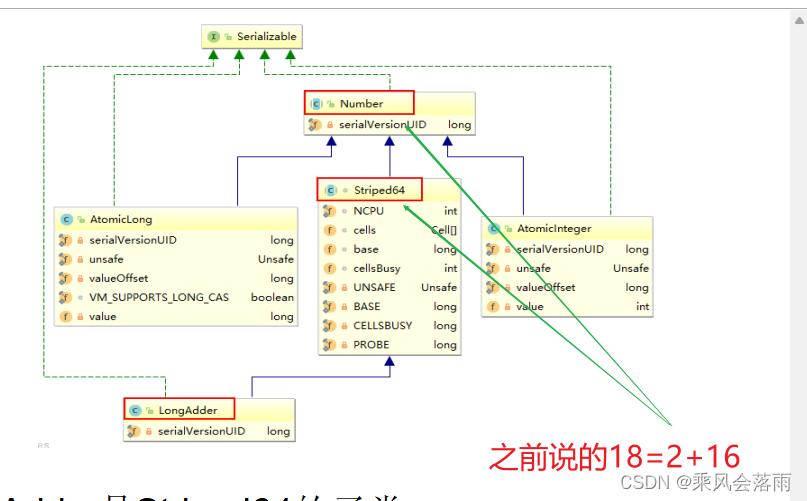
LongAdder yes Striped64 Subclasses of
public class LongAdder extends Striped64 implements Serializable {
private static final long serialVersionUID = 7249069246863182397L;
//---------------------------
abstract class Striped64 extends Number {
principle (LongAdder Why so soon? )
The official website description and Alibaba requirements
Ali explained

- Website shows
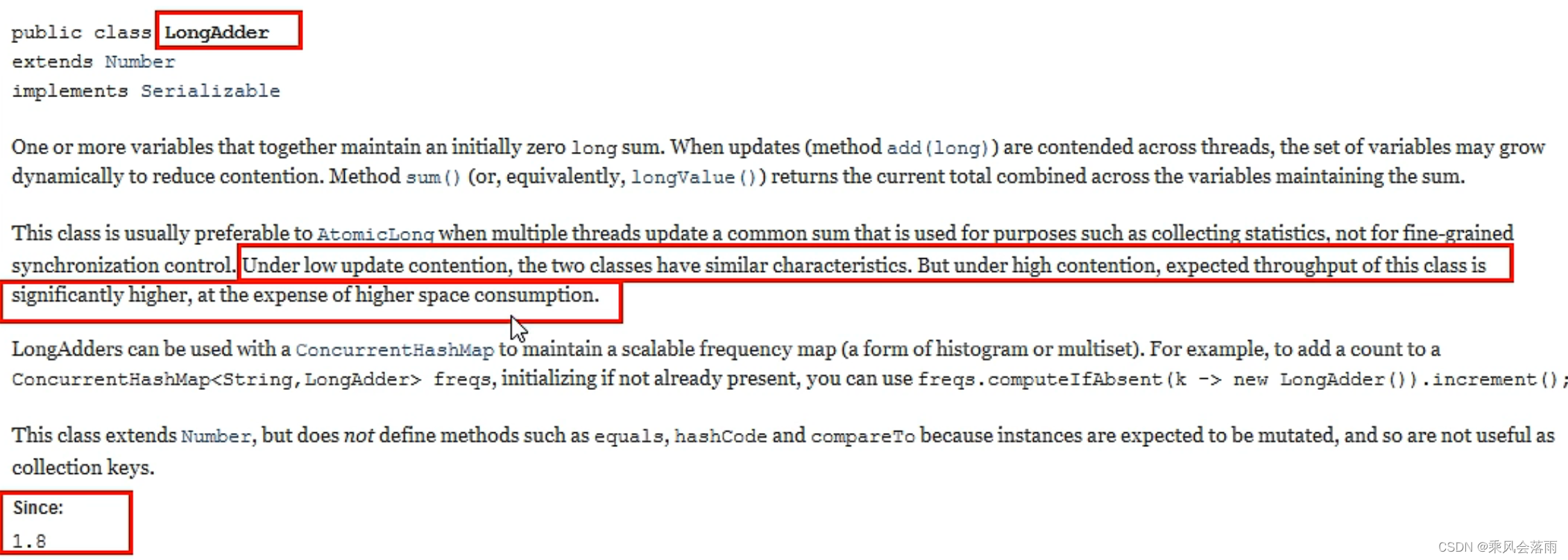
LongAdder yes Striped64 Subclasses of
Striped64
- Important member functions
//Number of CPUS, to place bound on table size
// CPU Number , namely cells The maximum length of an array
static final int NCPU = Runtime.getRuntime().availableProcessors();
//Table of cells. When non-null, size is a power of 2.
// Cell array |cells Array , by 2 The power of ,2,4,8,16....., Convenient for later bit operation
transient volatile Cell[] cells;
// Basics value value , When concurrency is low , Only accumulate this value. It is mainly used when there is no competition , adopt CAS to update .
//Base value, used mainly when there is no contention, but also as
//a fallback during table initialization races. Updated via CAS.
transient volatile long base;
// Create or expand Cells The spin lock variable used when array resizes the cell ( Capacity expansion ), Lock used when creating cells .
//Spinlock (locked via CAS) used when resizing and/or creating Cells.
transient volatile int cellsBusy;
The two most important
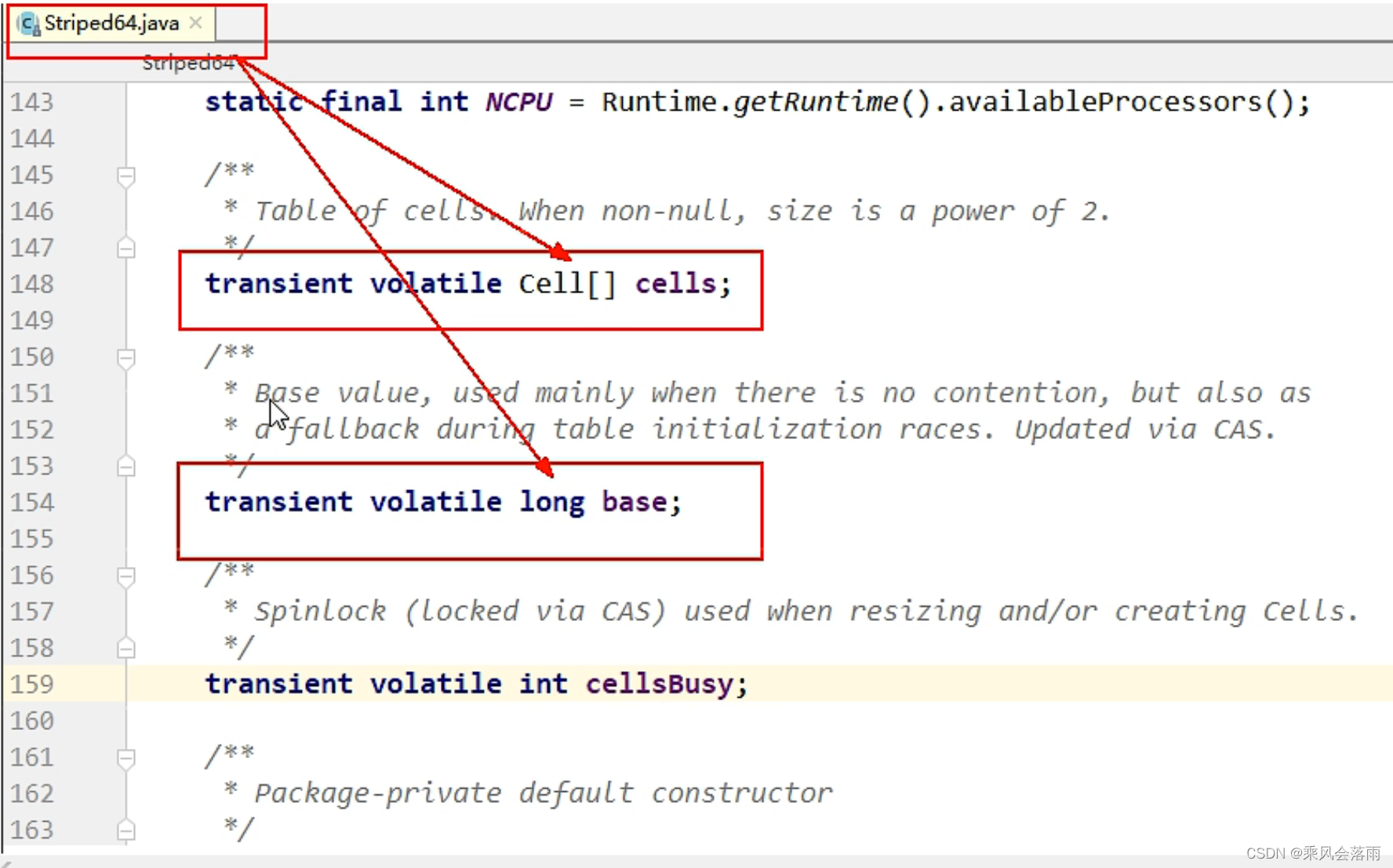
- Striperd64 Definition of some variables or methods in
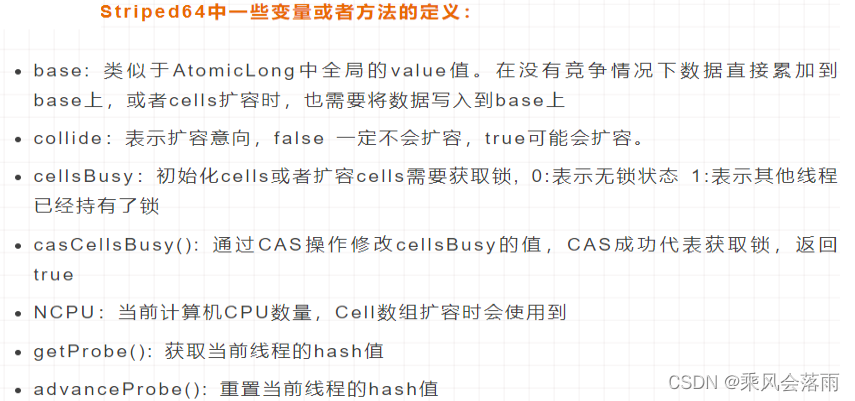
Cell
yes java.util.concurrent.atomic Next Striped64 A static inner class of
@sun.misc.Contended static final class Cell {
volatile long value;
Cell(long x) {
value = x; }
final boolean cas(long cmp, long val) {
return UNSAFE.compareAndSwapLong(this, valueOffset, cmp, val);
}
// Unsafe mechanics
private static final sun.misc.Unsafe UNSAFE;
private static final long valueOffset;
static {
try {
UNSAFE = sun.misc.Unsafe.getUnsafe();
Class<?> ak = Cell.class;
valueOffset = UNSAFE.objectFieldOffset
(ak.getDeclaredField("value"));
} catch (Exception e) {
throw new Error(e);
}
}
}
LongAdder Why so soon?
In fact, the situation is similar in small concurrency ; But in the case of high concurrency , stay AtomicLong in , The waiting thread will spin constantly , Resulting in low efficiency ; and LongAdder use cell[] Divided into several pieces , Finally, count the total result value (base+ be-all cell value ), Disperse hot spots .
An example of image , Buy train tickets at the railway station ,AtomicLong Just one window , Everyone else is waiting in line ; and LongAdder utilize cell Many ticket windows have been opened , So the efficiency is much higher .
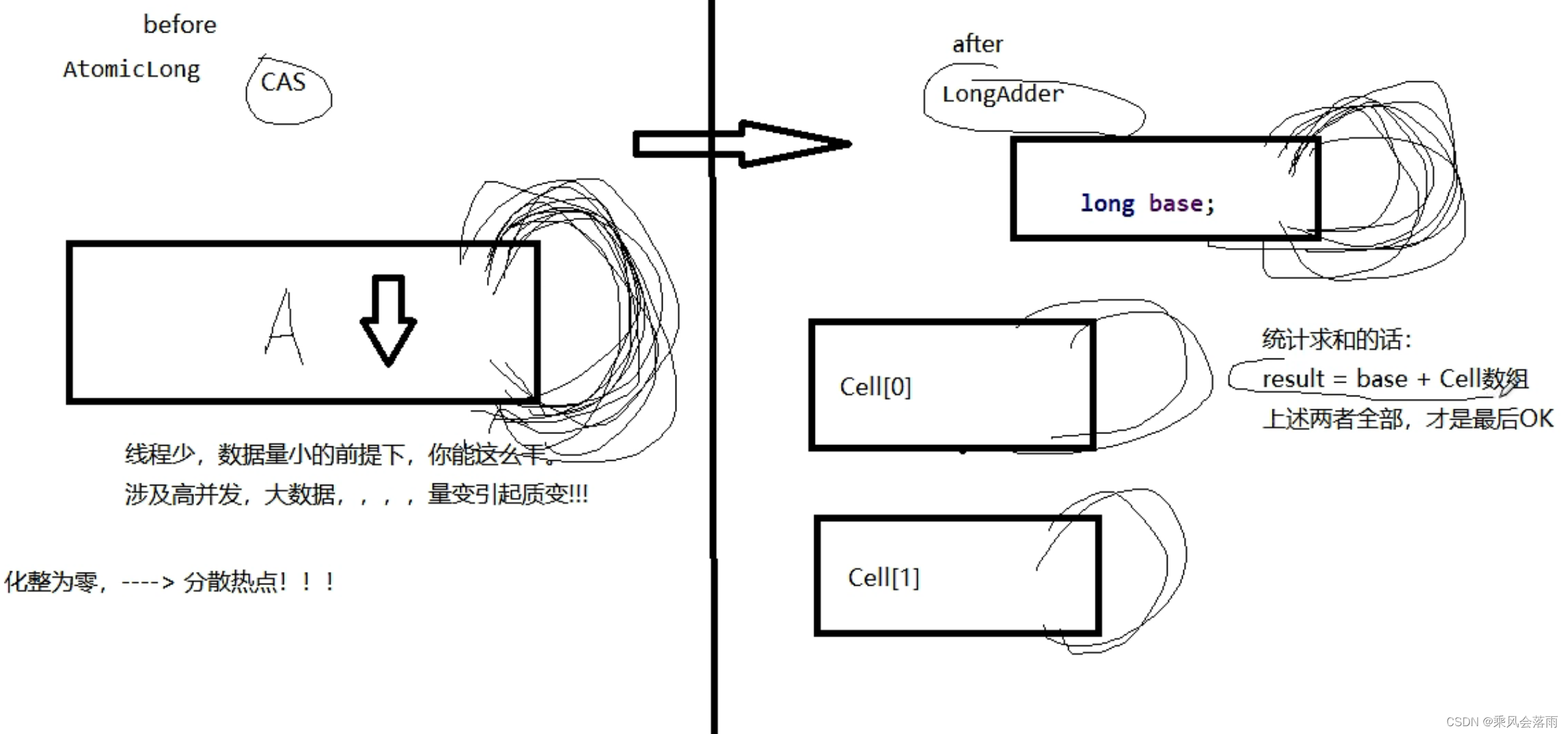
In a word
LongAdder The basic idea is Disperse hot spots , take value Scatter values into one Cell Array , Different threads will hit different slots in the array , Each thread only performs on that value in its own slot CAS operation , So the hot spots are scattered , The probability of conflict is much smaller . If you want to get real long value , Just add up the variable values in each slot and return to .
sum() Will bring all Cell Array value and base Accumulate as the return value , The core idea is to put the previous AtomicLong One value The update pressure is distributed to multiple value In the middle , So as to downgrade the update hotspot .
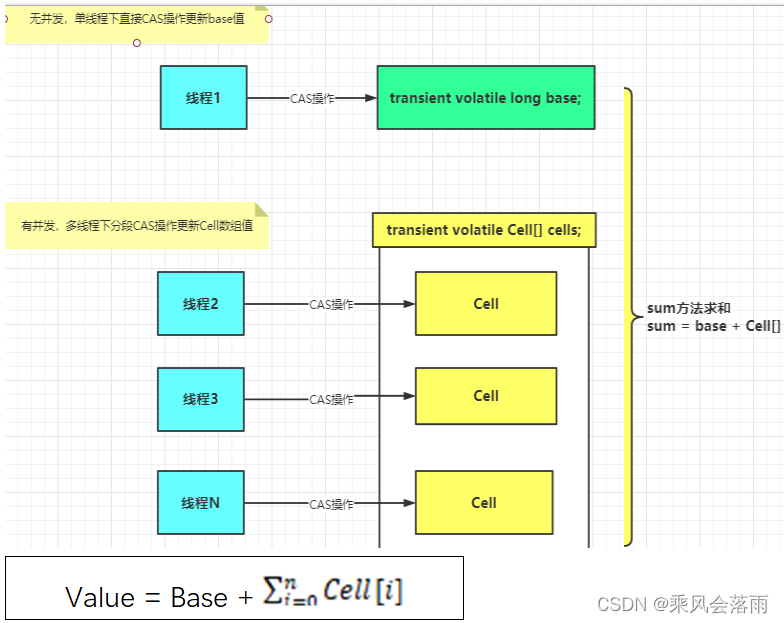
- Mathematical expression
There's a base Variable , One Cell[] Array .
base Variable : Under non competitive conditions , Add directly to the variable
Cell[] Array : Under competitive conditions , Accumulate the slots of each thread Cell[i] in
Source code interpretation and in-depth analysis
A small summary
LongAdder In the absence of competition , Follow AtomicLong equally , Yes The same base To operate , When there is a competitive relationship, it is the practice of breaking up the whole into parts , Change time from space , Use an array \ \ , Will a value Split into this array cells. Multiple threads need to pair at the same time value During operation , Can be on the thread id Conduct hash obtain hash value , According to hash Values are mapped to this array cells A subscript of , Then the value corresponding to the subscript is automatically increased . When all threads are finished , Will array cells All values and non competitive values base All add up as the final result .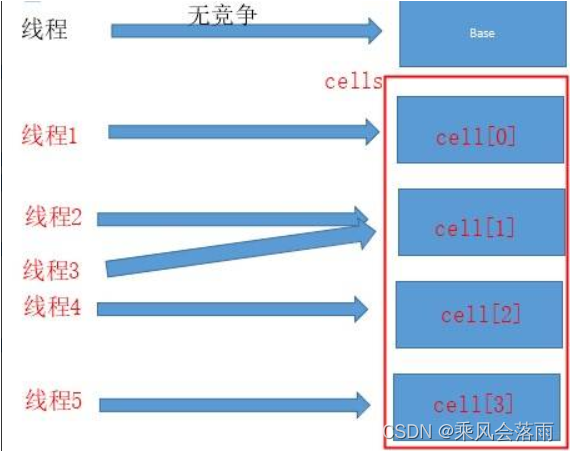
LongAdder.increment()
Second brush is required
- 1-add(1L)
public class LongAdder extends Striped64 implements Serializable {
private static final long serialVersionUID = 7249069246863182397L;
/*** Creates a new adder with initial sum of zero.* / public LongAdder() { } /*** Adds the given value.** @param x the value to add* / public void add(long x) { Cell[] as; long b, v; int m; Cell a; if ((as = cells) != null || !casBase(b = base, b + x)) { boolean uncontended = true; if (as == null || (m = as.length - 1) < 0 || (a = as[getProbe() & m]) == null || !(uncontended = a.cas(v = a.value, v + x))) longAccumulate(x, null, uncontended); } } // What really works is longAccumulate //as Express cells quote //b Represents the acquired base value //v Indicates the expected value //m Express cells Length of array //a Represents the hit of the current thread cell Cell uncontended Represents no conflict .
Let's click in this casBase I found that he was also a CAS
final boolean casBase(long cmp, long val) {
return UNSAFE.compareAndSwapLong(this, BASE, cmp, val);
}
At first, when the competition was small CAS To succeed , That is to say casBase To succeed , then cells It's also empty , So it won't go into the cycle
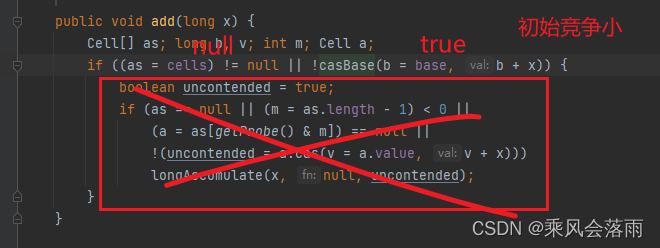
When the competition is big , He will Cell[] rs = new Cell[2]; Two new cell, here ≠ null , The conditions are met , Into the loop .
Then there is another layer of circulation , Here are several if side by side
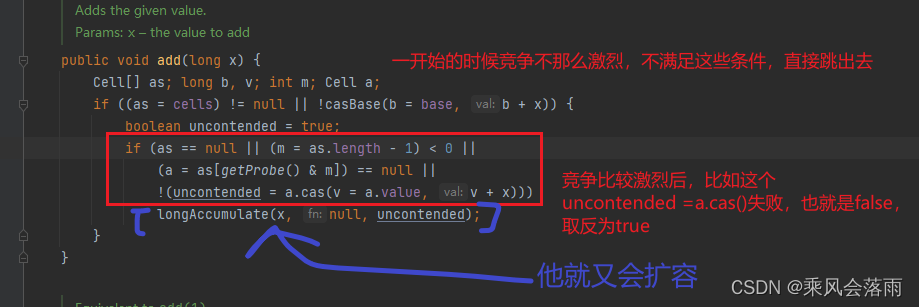
To sum up
1. Only update when there is no competition at first base;
2. If updated base After failure , Create a new one for the first time Cell[] Array
3. When multiple threads compete for the same Cell When the price competition is fierce , It may be necessary to uselongAccumulateYes Cell[] Capacity expansion .
Once again, I want to summarize
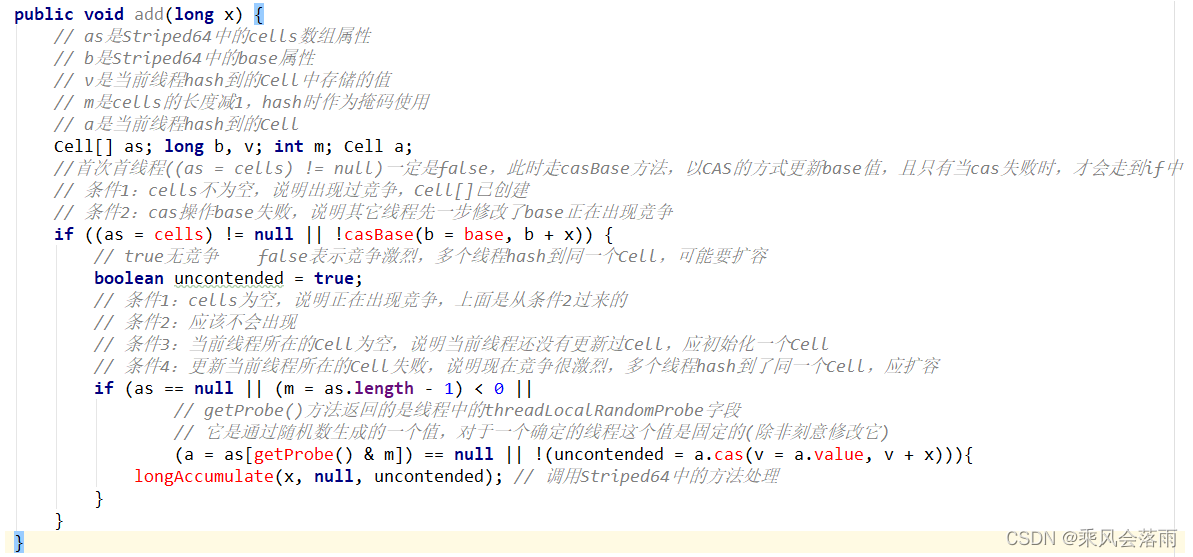
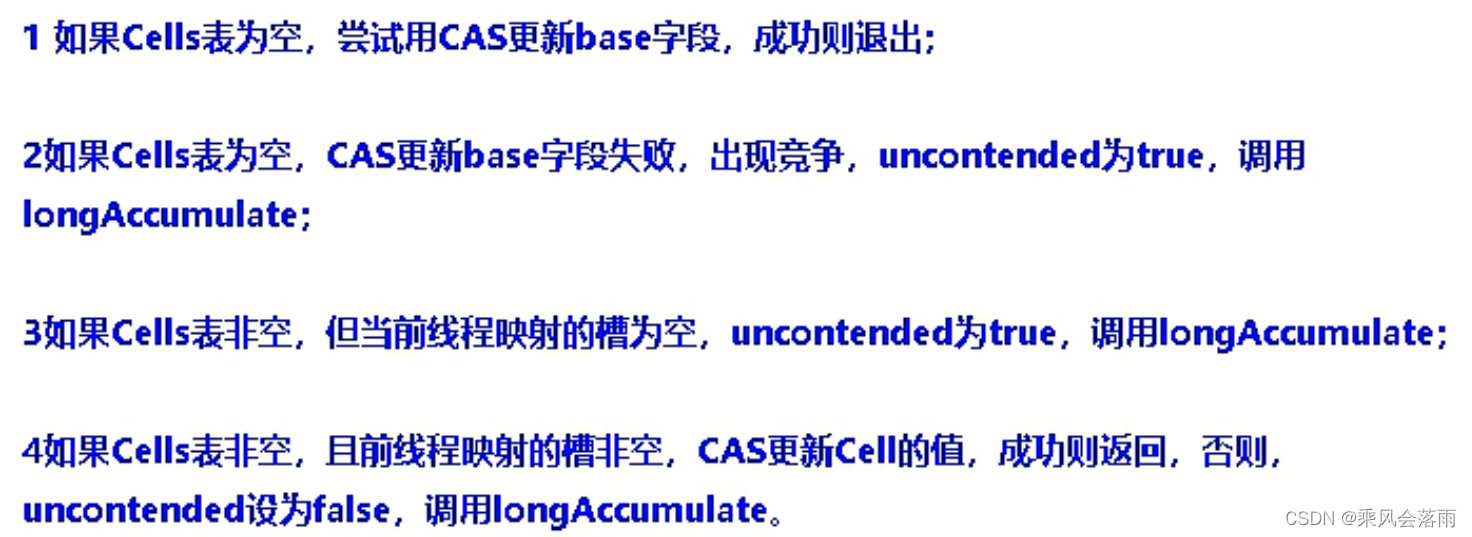
2-longAccumulate
final void longAccumulate(long x, LongBinaryOperator fn,
boolean wasUncontended) {
int h;
if ((h = getProbe()) == 0) {
ThreadLocalRandom.current(); // force initialization
h = getProbe();
wasUncontended = true;
}
boolean collide = false; // True if last slot nonempty
for (;;) {
Cell[] as; Cell a; int n; long v;
if ((as = cells) != null && (n = as.length) > 0) {
// Here is ③ Cell The array is no longer empty and may exist Cell Array capacity
if ((a = as[(n - 1) & h]) == null) {
if (cellsBusy == 0) {
// Try to attach new Cell
Cell r = new Cell(x); // Optimistically create
if (cellsBusy == 0 && casCellsBusy()) {
boolean created = false;
try {
// Recheck under lock
Cell[] rs; int m, j;
if ((rs = cells) != null &&
(m = rs.length) > 0 &&
rs[j = (m - 1) & h] == null) {
rs[j] = r;
created = true;
}
} finally {
cellsBusy = 0;
}
if (created)
break;
continue; // Slot is now non-empty
}
}
collide = false;
}
else if (!wasUncontended) // CAS already known to fail
wasUncontended = true; // Continue after rehash
else if (a.cas(v = a.value, ((fn == null) ? v + x :
fn.applyAsLong(v, x))))
break;
else if (n >= NCPU || cells != as)// No more than cpu Check the number
collide = false; // At max size or stale
else if (!collide)
collide = true;
else if (cellsBusy == 0 && casCellsBusy()) {
try {
if (cells == as) {
// Expand table unless stale
Cell[] rs = new Cell[n << 1];// Capacity expansion - The left one , amount to x2
for (int i = 0; i < n; ++i)
rs[i] = as[i];
cells = rs;
}
} finally {
cellsBusy = 0;
}
collide = false;
continue; // Retry with expanded table
}
h = advanceProbe(h);
}
else if (cellsBusy == 0 && cells == as && casCellsBusy()) {
// Here is ① initialization
boolean init = false;
try {
// Initialize table
if (cells == as) {
Cell[] rs = new Cell[2];
rs[h & 1] = new Cell(x);
cells = rs;
init = true;
//------ You can look here first , It's initialized , The length is 2
//------cells Array , by 2 The power of ,2,4,8,16, Convenient for later bit operation
}
} finally {
cellsBusy = 0;
}
if (init)
break;
}
else if (casBase(v = base, ((fn == null) ? v + x :
fn.applyAsLong(v, x))))// Here is ② The bottom line
break; // Fall back on using base
}
}
- LongAccumulate Introduction

- Striped64 Definition of some variables or methods in
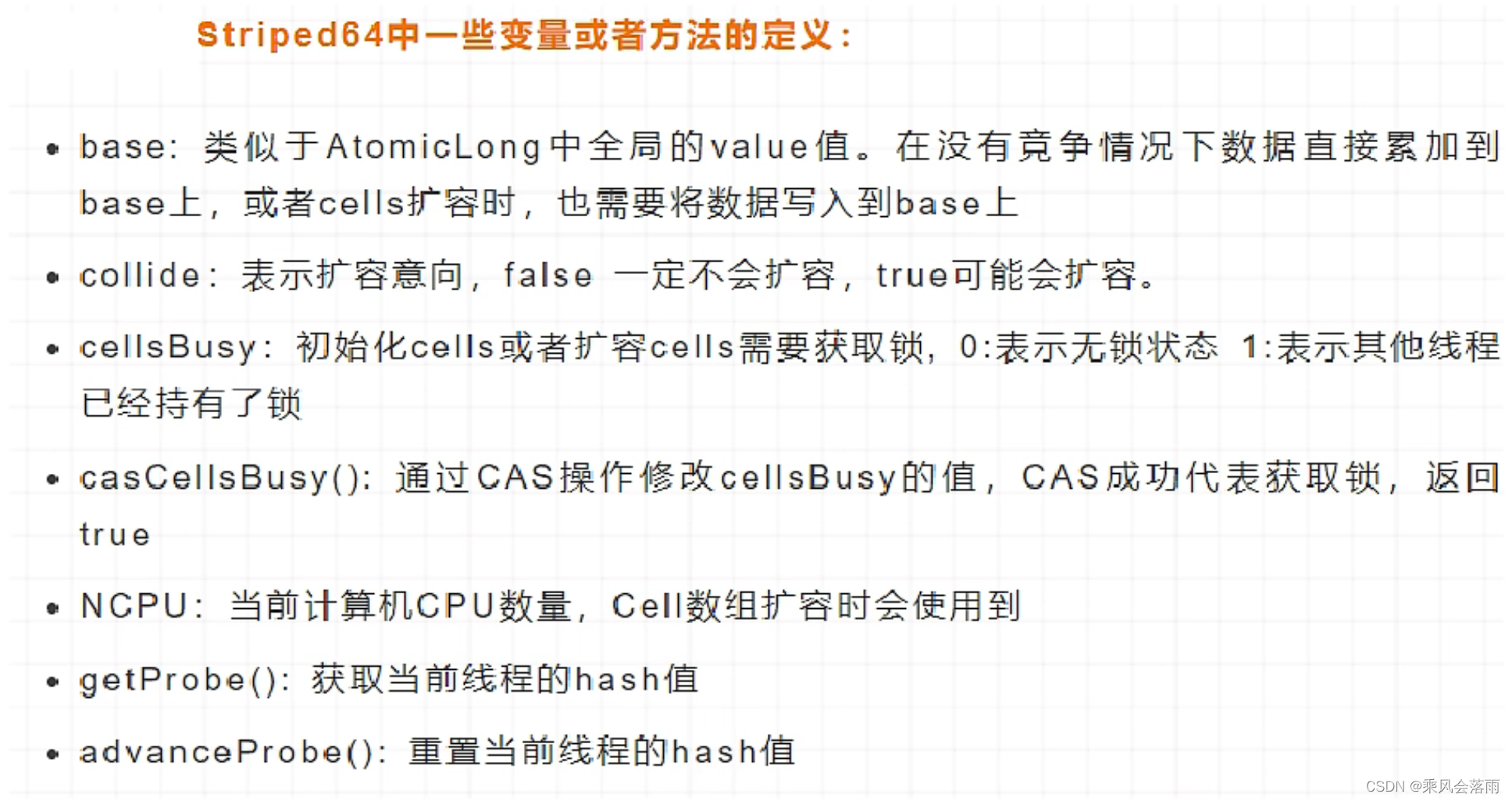
step
Let's talk about this first
(a = as[getProbe() & m])Inside probe, I actually took it here hash value , adopt hash It's worth knowing where we're going cell Slot
static final int getProbe() {
return UNSAFE.getInt(Thread.currentThread(), PROBE);
}
// In fact, you get the thread Hash value
So the first paragraph is like a new employee getting a job number (hash value ) equally 
- general programme
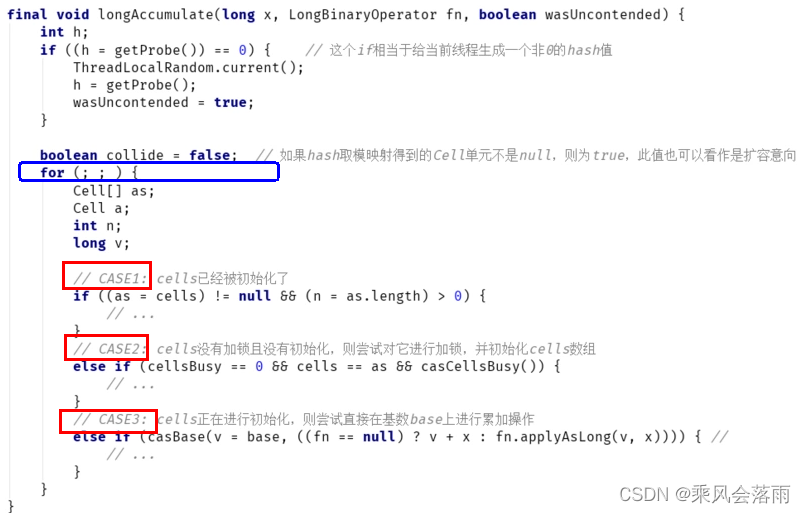
The above code first assigns a to the current thread hash value , And then into a for(;;) The spin , This spin is divided into three branches :
CASE1:Cell[] Array has been initialized
CASE2:Cell[] Array not initialized ( New for the first time )
CASE3:Cell[] Array initializing
- Calculation
① Just about to initialize Cell[] Array ( New for the first time )
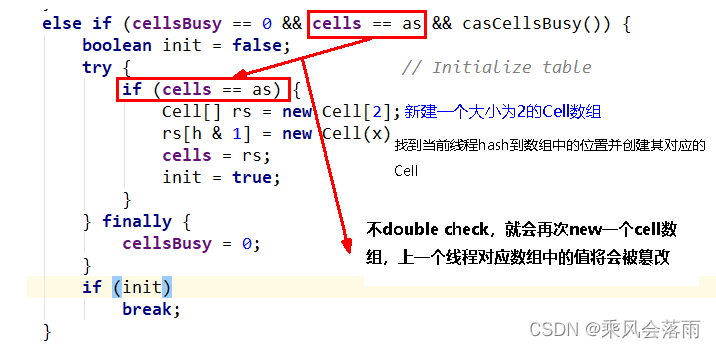
If the above conditions are executed successfully, the initialization and assignment of the array will be executed , Cell[] rs = new Cell[2] Indicates that the length of the array is 2,
rs[h & 1] = new Cell(x) To create a new Cell Elements ,value yes x value , The default is 1.
h & 1 Similar to before us HashMap Commonly used calculation hash bucket index The algorithm of , Is usually hash & (table.len - 1). Same as hashmap One meaning .
② The bottom line
Multiple threads try CAS The thread that fails to modify will go to this branch
// At the bottom
else if (casBase(v = base, ((fn == null) ? v + x :
fn.applyAsLong(v, x))))
// This branch implements direct operations base base , Accumulate the value to base On , That is, other threads are initializing , Multiple threads are updating base Value .
③Cell The array is no longer empty and may exist Cell Array capacity
Multiple threads hit one at the same time cell competition , This is The most complicated Part of
(1)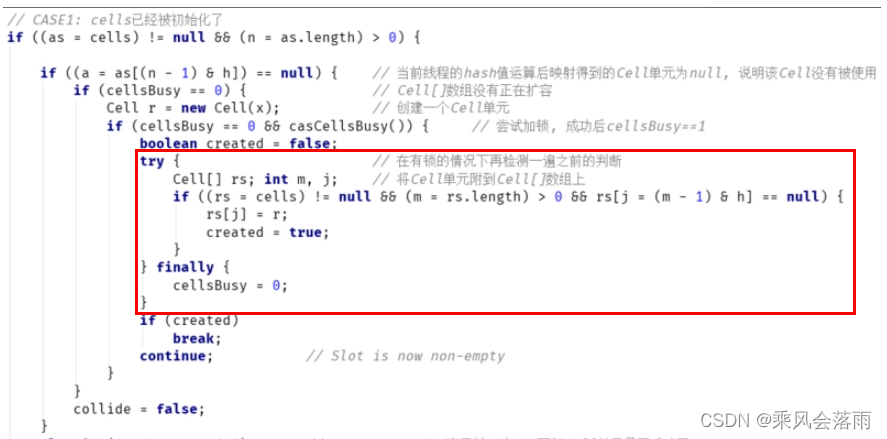
The above code determines the current thread hash Whether the data location element pointed to after is empty ,
If it is empty, it will Cell Put the data into the array , Out of the loop .
If it is not empty, continue the cycle .
(2)
![[ Failed to transfer the external chain picture , The origin station may have anti-theft chain mechanism , It is suggested to save the pictures and upload them directly (img-BDY3L1CW-1656407207550)(image/image_miqNJM3b9d.png)]](/img/29/31dc291e0792625dd19ee967875fef.png)
(3)

Indicates that there is data in the array corresponding to the current thread , Also reset hash value ,
At this time through CAS The operation attempts to the current number of value Value is added up x operation ,x The default is 1, If CAS Success directly jumps out of the loop .
(4)
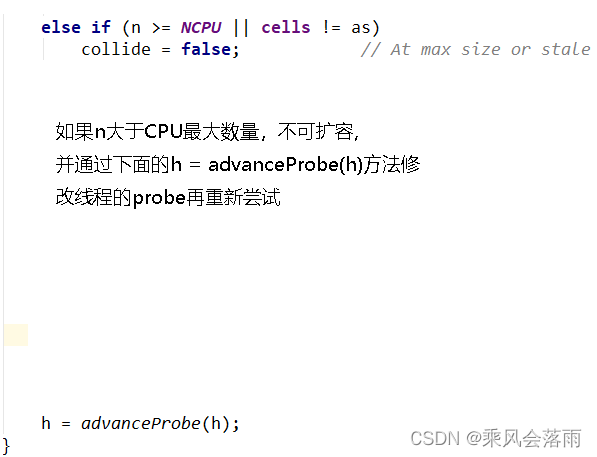
(5)
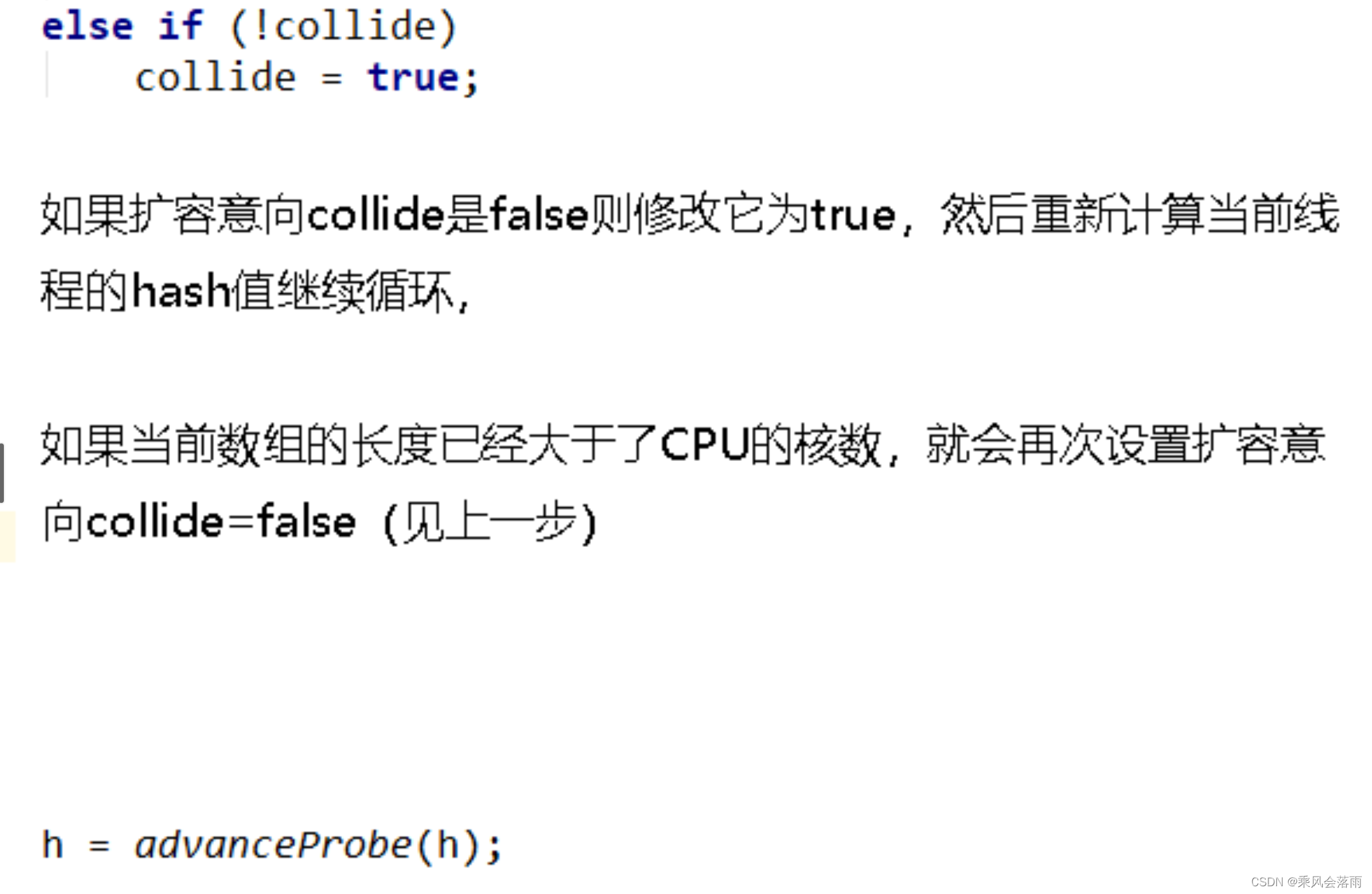
(6)
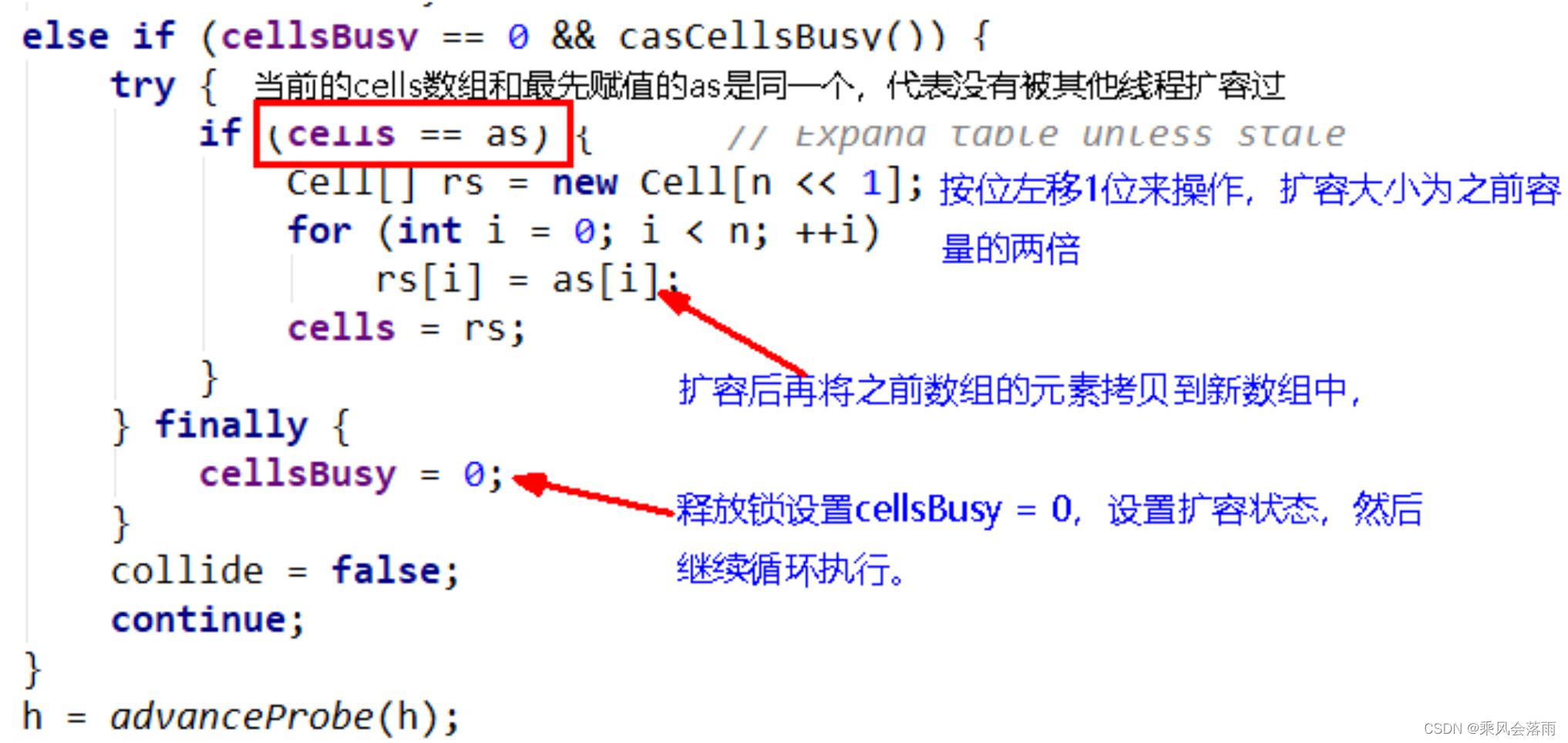
- The above six steps are summarized
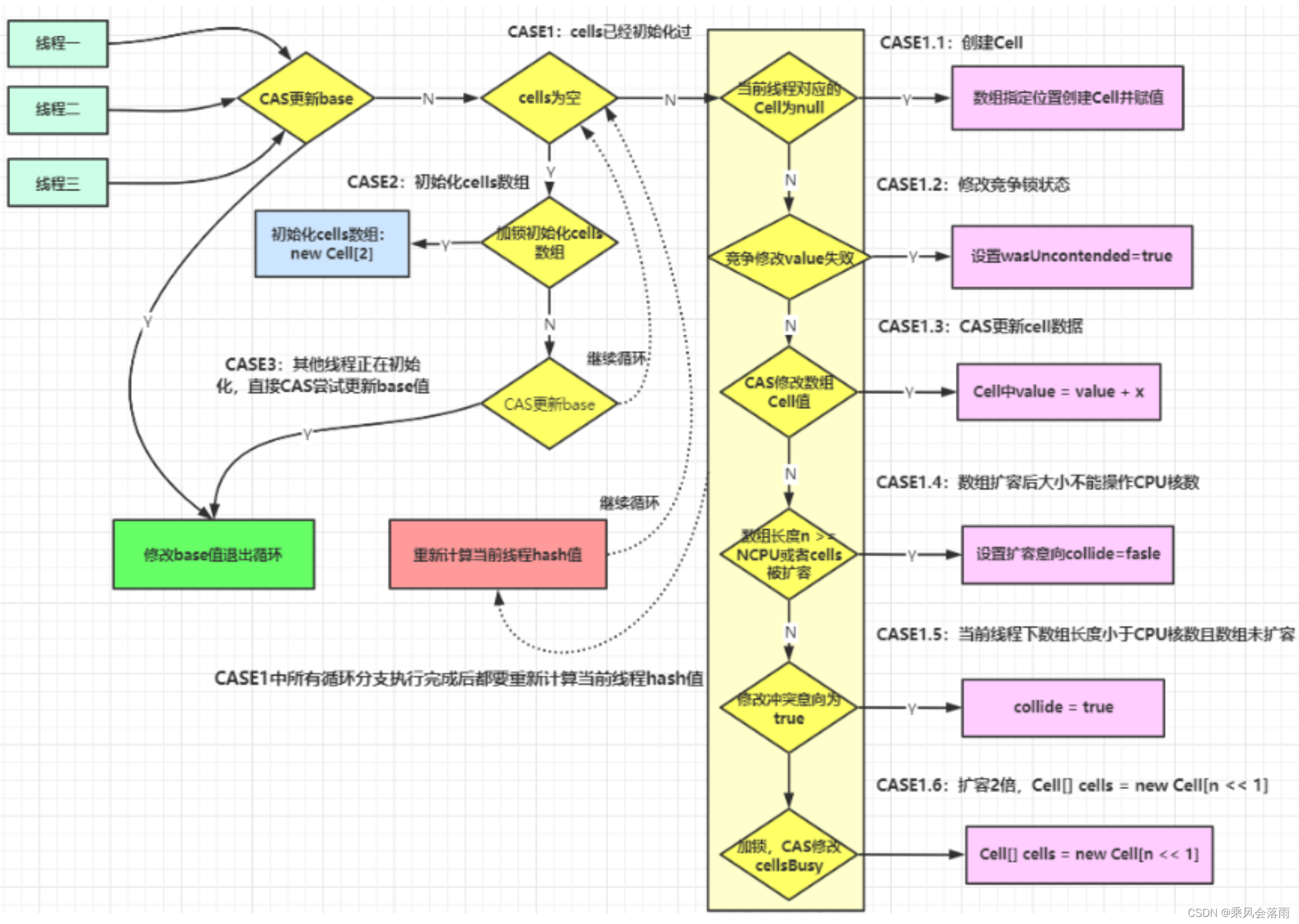
3-sum
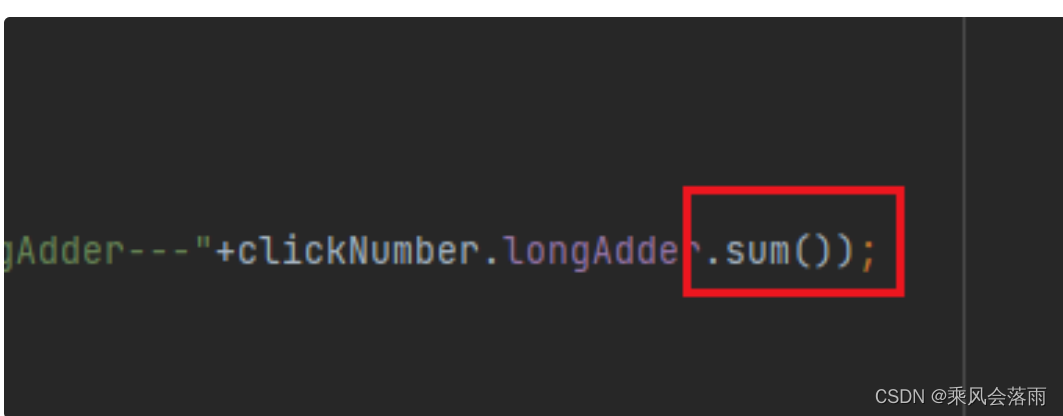
//LongAdder.java
public long sum() {
Cell[] as = cells; Cell a;
long sum = base;
if (as != null) {
for (int i = 0; i < as.length; ++i) {
if ((a = as[i]) != null)
sum += a.value;
}
}
return sum;
}
sum() Will bring all Cell Array value and base Add up As return value .
The core idea is to put the previous AtomicLong One value The update pressure is distributed to multiple value In the middle , So as to downgrade the update hotspot .
Why in the case of concurrency sum The value of is not accurate ?
sum Execution time , There is no limit to base and cells Update ( A deadly word ). therefore LongAdder Not strong consistency Of , It is Final consistency Of .
First , Finally returned sum local variable , The initial is copied as base, And when you finally return , Probably base Has been updated , At this point, the local variable sum Will not update , To cause disagreement .
secondly , Here to cell The read of cannot be guaranteed to be the last written value . therefore ,sum Methods without concurrency , You can get the right results .
Use summary
AtomicLong
Thread safety , Some performance loss is allowed , When high precision is required, it can be used
Guarantee accuracy , Performance cost
AtomicLong Multiple threads for a single hotspot value value Perform atomic operations
LongAdder
When it is necessary to have good performance under high and low performance , And the accuracy of the value is not high , have access to
Guaranteed performance , The cost of accuracy
LongAdder Each thread has its own slot , Each thread generally only checks the value in its own slot CAS operation
A small summary
AtomicLong
principle
CAS+ The spin
incrementAndGet
scene
Global computing under low concurrency
AtomicLong It can ensure the accuracy of counting in case of concurrency , It passes through CAS To solve the problem of concurrency security
defects
The performance drops sharply after high concurrency
why?AtomicLong The spin of will be called a bottleneck (N Threads CAS Modify the operation value of the thread , Only one has succeeded at a time , Other N - 1 Failure , The failure keeps spinning until success , Such a large number of failed spins , once cpu Just hit high .)
LongAdder
principle
CAS+Base+Cell Array scatter
Space changes time and disperses hot data
scene
Highly concurrent global computing
defects
sum If the calculation thread modifies the result after summation , The final result is not accurate enough
边栏推荐
猜你喜欢
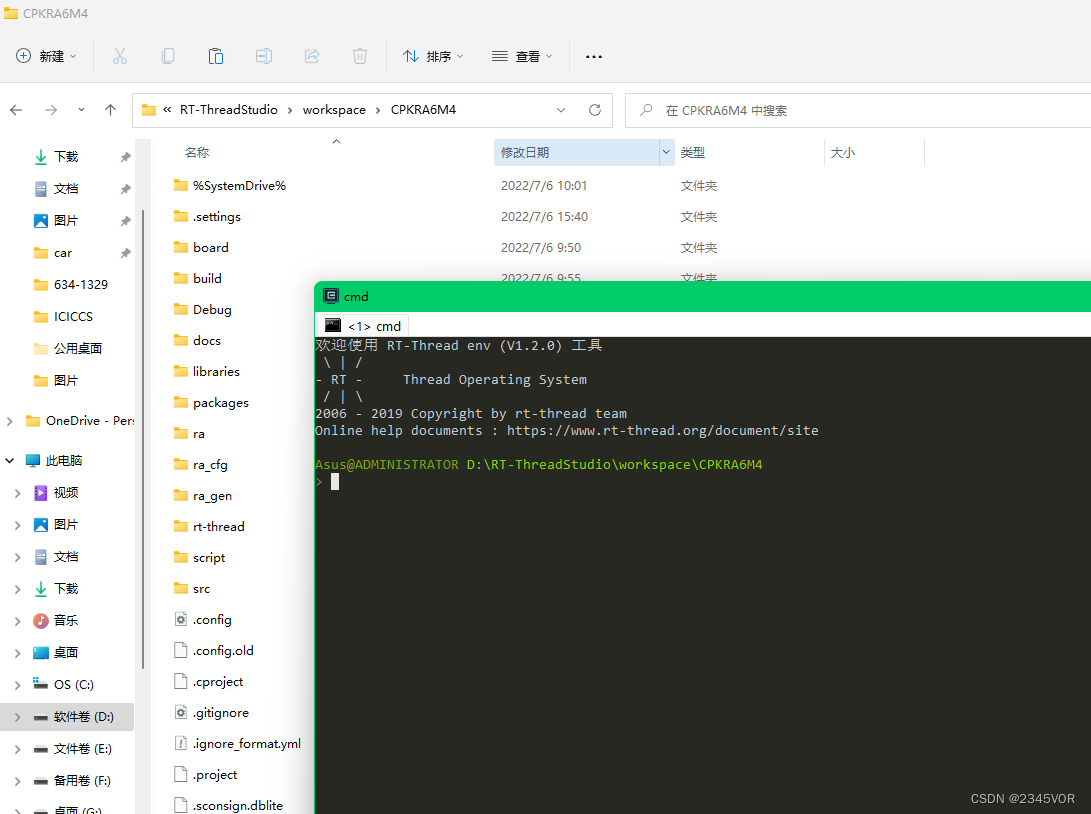
【RT-Thread env 工具安装】
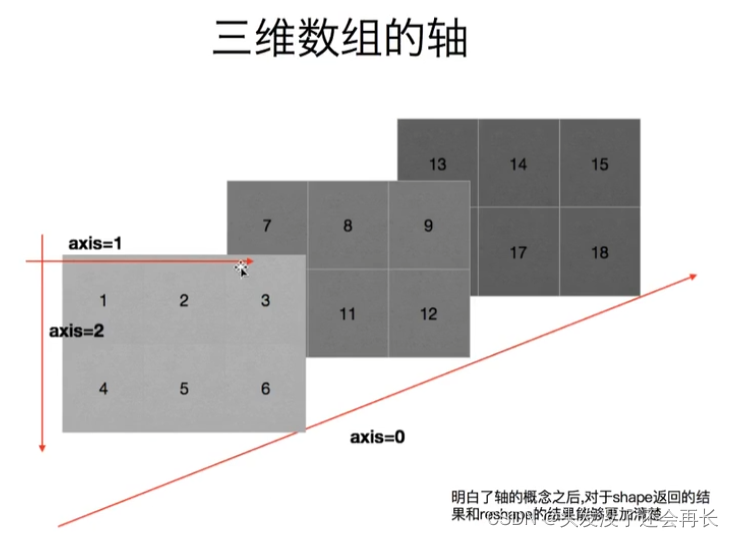
Numpy——axis
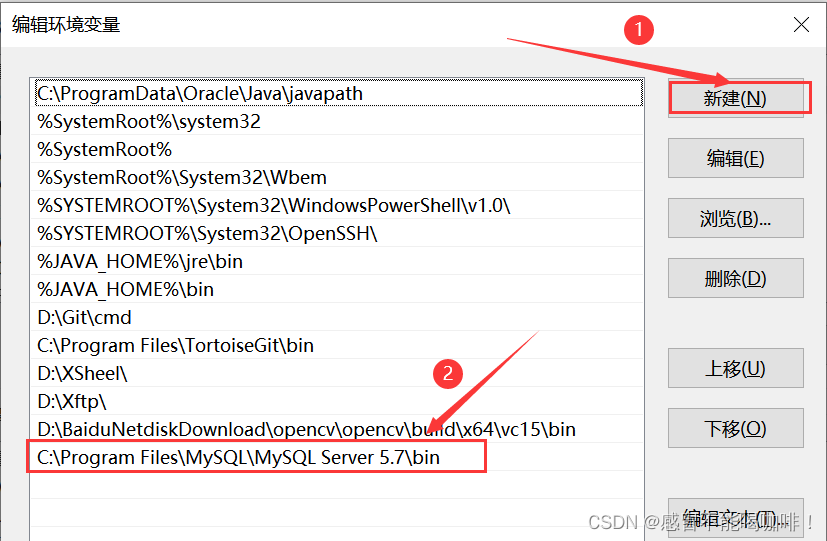
cmd命令进入MySQL时报服务名或者命令错误(傻瓜式教学)
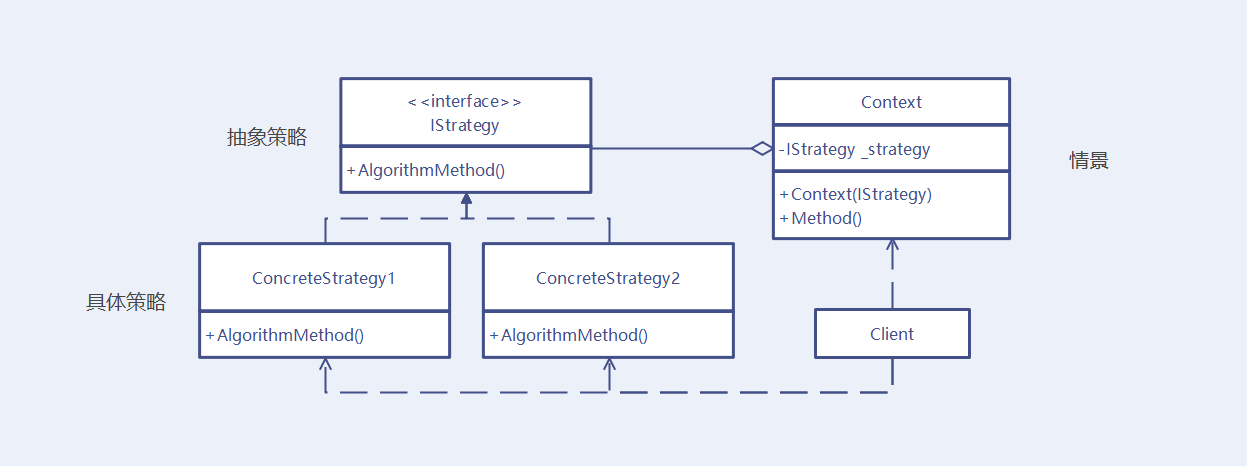
Policy mode - unity

Kirin Xin'an cloud platform is newly upgraded!
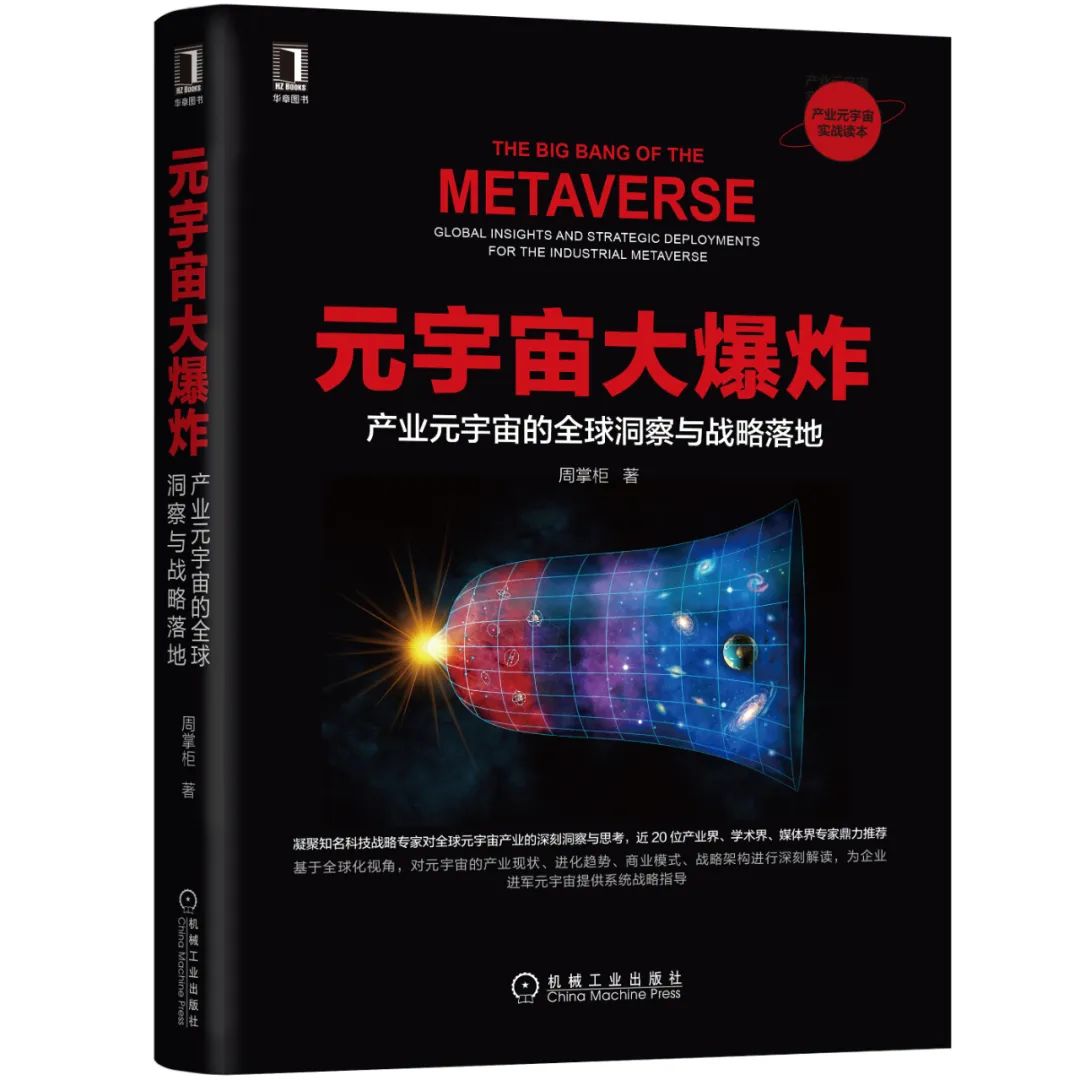
In the first half of 2022, I found 10 books that have been passed around by my circle of friends
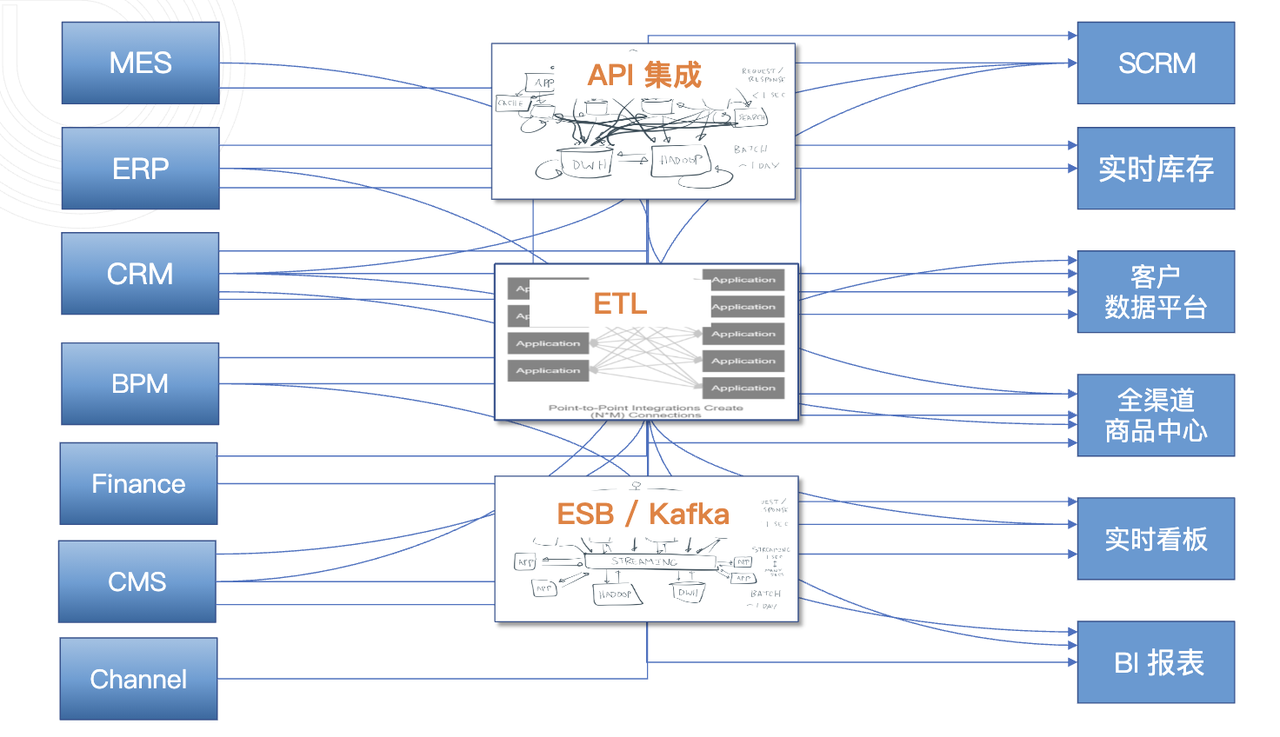
Version 2.0 of tapdata, the open source live data platform, has been released
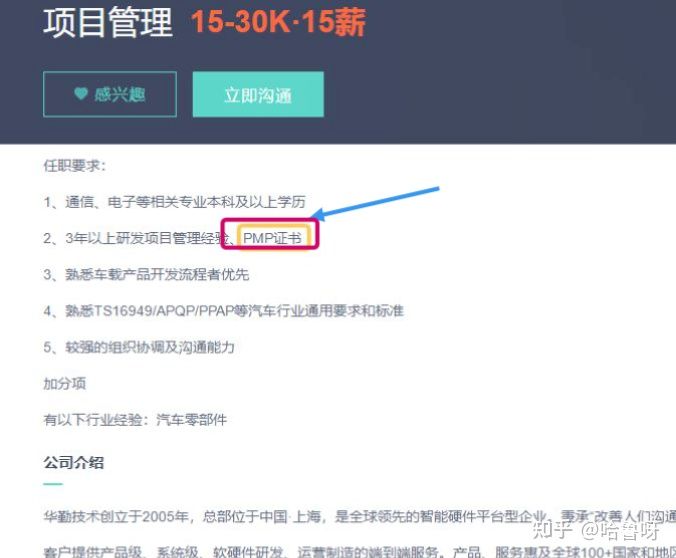
Le PGR est - il utile au travail? Comment choisir une plate - forme fiable pour économiser le cœur et la main - d'œuvre lors de la préparation de l'examen!!!

PV静态创建和动态创建
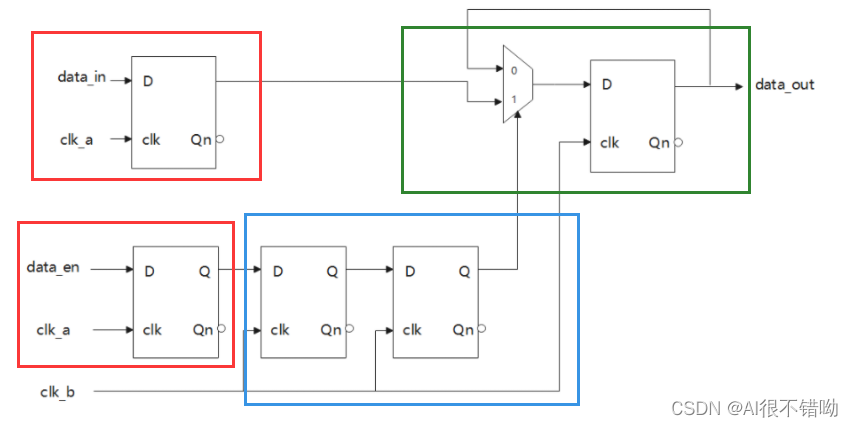
【牛客网刷题系列 之 Verilog进阶挑战】~ 多bit MUX同步器
随机推荐
现在股票开户可以直接在网上开吗?安全吗。
R语言dplyr包mutate_at函数和min_rank函数计算dataframe中指定数据列的排序序号值、名次值、将最大值的rank值赋值为1
Policy mode - unity
9 原子操作类之18罗汉增强
IP 工具类
微服务远程Debug,Nocalhost + Rainbond微服务开发第二弹
Business experience in virtual digital human
L1-019 who falls first (Lua)
How to open an account for stock speculation? Excuse me, is it safe to open a stock account by mobile phone?
Matplotlib drawing 3D graphics
PMP對工作有益嗎?怎麼選擇靠譜平臺讓備考更省心省力!!!
2022年投资哪个理财产品收益高?
R语言ggplot2可视化:使用ggpubr包的ggdensity函数可视化分组密度图、使用stat_overlay_normal_density函数为每个分组的密度图叠加正太分布曲线
Longest common prefix (leetcode question 14)
Numpy——axis
Kirin Xin'an won the bid for the new generation dispatching project of State Grid!
Numpy——axis
R语言ggplot2可视化:使用ggpubr包的ggecdf函数可视化分组经验累积密度分布函数曲线、linetype参数指定不同分组曲线的线型
Kunpeng developer summit 2022 | Kirin Xin'an and Kunpeng jointly build a new ecosystem of computing industry
多个kubernetes集群如何实现共享同一个存储